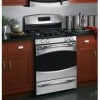GE PGB900 Owners Manual - Page 21
Meats, Minutes/Lb., Oven Temp., Internal Temp., Seafood, Poultry
 |
View all GE PGB900 manuals
Add to My Manuals
Save this manual to your list of manuals |
Page 21 highlights
Safety Instructions Operating Instructions GEAppliances.com Meats Minutes/Lb. Oven Temp. Internal Temp. Beef Pork Ham Lamb Seafood Rib (3 to 5 lbs.) Boneless Rib, Top Sirloin Beef Tenderloin Pot Roast (21/2 to 3 lbs.) chuck, rump Bone-in (3 to 5 lbs.) Boneless (3 to 5 lbs.) Pork Chops (1/2" to 1" thick) Canned (3 lbs. fully cooked) Butt (5 lbs. fully cooked) Shank (5 lbs. fully cooked) Bone-in (3 to 5 lbs.) Boneless (3 to 5 lbs.) Fish, whole (3 to 5 lbs.) Rare† Medium Well Rare† Medium Well Rare† Medium 2 chops 4 chops 6 chops Medium Well Medium Well 20-24 24-28 28-32 20-24 24-28 28-32 10-14 14-18 35-45 23-27 23-27 30-35 total 35-40 total 40-45 total 14-18 14-18 14-18 17-20 20-24 17-20 20-24 30-40 total 325˚F 325˚F 325˚F 325˚F 325˚F 325˚F 325˚F 325˚F 300˚F 325˚F 325˚F 325˚F 325˚F 325˚F 325˚F 325˚F 325˚F 325˚F 325˚F 325˚F 325˚F 400˚F 140˚F 160˚F 170˚F 140˚F 160˚F 170˚F 140˚F 160˚F 170˚F 170˚F 170˚F 170˚F 170˚F 170˚F 140˚F 140˚F 140˚F 160˚F 170˚F 160˚F 170˚F Poultry Lobster Tails (6 to 8 oz. each) Whole Chicken (21/2 to 31/2 lbs.) Cornish Hens Unstuffed (1 to 11/2 lbs.) Cornish Hens Stuffed (1 to 11/2 lbs.) 20-25 total 24-26 50-55 total 55-60 total 350˚F 350˚F 350˚F 350˚F 180˚-185˚F 180˚-185˚F 180˚-185˚F Duckling (4 to 5 lbs.) 24-26 325˚F 180˚-185˚F Turkey, whole* Unstuffed (10 to 16 lbs.) Unstuffed (18 to 24 lbs.) 8-11 325˚F 180˚-185˚F 7-10 325˚F 180˚-185˚F Turkey Breast (4 to 6 lbs.) 16-19 325˚F 170˚F * Stuffed birds generally require 30-45 minutes additional roasting time. Shield legs and breast with foil to prevent overbrowning and drying of skin. †The U.S. Department of Agriculture says "Rare beef is popular, but you should know that cooking it to only 140˚F means some food poisoning organisms may survive." (Source: Safe Food Book. Your Kitchen Guide. USDA Rev. June 1985.) Installation Instructions Troubleshooting Tips Consumer Support 21















